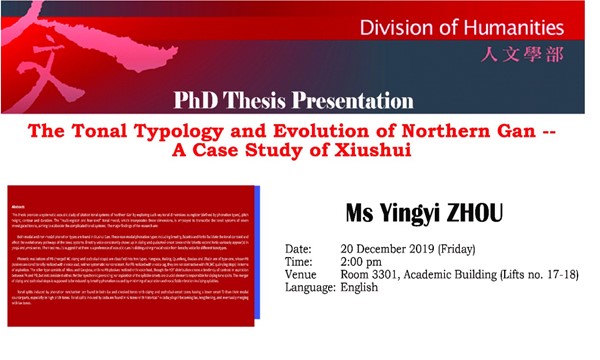Abstract:
This thesis provides a systematic acoustic study of citation tonal systems of Northern Gan by exploring such key tonal dimensions as register(defined by phonation types), pitch height, contour and duration. The “multi-register and four-level” tonal model, which incorporates those dimensions, is employed to transcribe the tonal systems of seven investigated towns, aiming to elaborate the complicated tonal systems. The major findings of the research are:
Both modal and non-modal phonation types are found in Xiushui Gan. These non-modal phonation types including breathy, falsetto and fortis facilitate the tonal contrast and affect the evolutionary pathways of the tonal systems. Breathy voice consistently shows up in cìqīng and quánzhuó-onset tones while falsetto or/and fortis variously appear(s) in yīnqù and yīnrù series. The t-test results suggest that there is a preference of acoustic cues in distinguishing modal voice from breathy voice for different tonotypes.
Phonetic realizations of PB (merged MC cìqīng and quánzhuó stops) are classified into two types. Hangkou, Bailing, Quanfeng, Daqiao and Zhajin are of type one, whose PB plosives are conditionally realized with a voice lead, neither systematic nor consistent. For PB realized with a voice lag, they are not contrastive with PA (MC quánqīng stops) in terms of aspiration. The other type consists of Xikou and Gangkou, with no PB plosives realized with voice lead, though the VOT distribution shows a tendency of contrast in aspiration between PA and PB, but not consistent either. Neither synchronic prevoicing nor aspiration of the syllable onsets are crucial elements responsible for cìqīng tone splits. The merger of cìqīng and quánzhuó stops is supposed to be induced by breathy phonation caused by mistiming of aspiration and vocal folds vibration in cìqīng syllables.
Tonal splits induced by phonation mechanism are found in both lax and checked tones with cìqīng and quánzhuó-onset tones having a lower onset f0 than their modal counterparts, especially in high pitch tones. Tonal splits induced by coda are found in rù tones with historical *-k coda yángrù becoming lax, lengthening, and eventually merging with lax tones.
In sum, the various phonation types and coda difference lead to exceedingly complex tonal systems with toneme number varying from ten to sixteen in Xiushui Gan. The research also strongly implies that the tonal systems should be understood in a multi-dimension perspective and the distinctive feature may consist of a bunch of acoustic cues. The phonological system should be treated as a dynamic system instead of a static system and the intra- and inter-individual variants should not be eliminated as they may indicate possible directions of tonal evolution.
https://engage.ust.hk/event/5273295
huma@ust.hk
